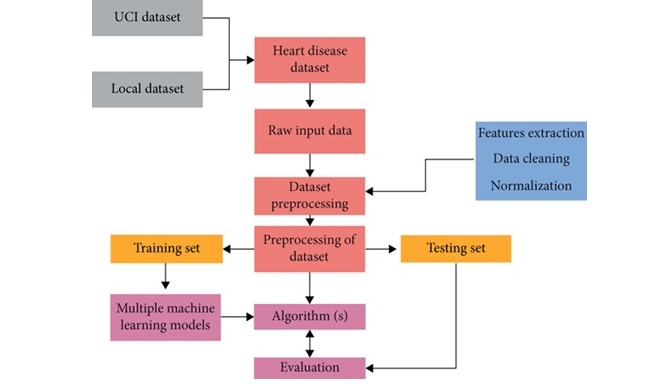Heart Disease Prediction by using Random Forest Classifier

DOI:
https://doi.org/10.54060/jase.v3i2.29Keywords:
Heart disease prediction, alkaline water and health, Random Forest Classifier AlgorithmAbstract
This research presents data on a Machine Learning-based Artificial Intelligence system used in predicting cardiac illness. In this research, we learn how advances in machine learning have improved our ability to foresee who will and will not get heart disease. In both developed and less developed, non-industrialized countries, cardiovascular dis- eases are majorly the main reason of immortality for decades. Reducing mortality from cardiovascular infections requires both early detection and constant clinical supervision. However, it is unrealistic to expect accurate, consistent patient screening, and having a specialist confer with a patient for 24 hours isn't feasible due to the additional knowledge, time, and training it would require. Here, we have used ML algorithms and methods which are likely as linear regression, Random Forest, Decision tree, SVM, KNN, and others to construct and explore models for coronary sickness expectancy via the various cardiac attributes of patient and to spot impending coronary ill-ness. For more accurate diagnosis of heart infections, a Random Forest is developed. Due to its near-perfect accuracy in data preparation, this application necessitates thorough data analysis.
Downloads
References
T. Das and -. Sengur, “Effective analysis of coronary illness through AI models,” in Master frameworks with appli- cations, 2009.
J. Vanisree, “Choice Help model for Coronary illness anticipation in light of early indications of 8-51 patients utilizing parallel grouping,” in Global Diary of PC Applications, 2011.
Zhang- "Concentrates on utilization of Help Vector Machines in coronary illness expectation model", Electromagnetic Field Issues and Applications, 6th Worldwide Meeting (ICEF), IEEE 2012.
H. Elshazly, “Lymph sicknesses expectation in view of help vector machine calculation,” in PC Designing and 24 IITM Diary of the executives and IT Frameworks ninth Global Meeting (ICCES), 2014.
B. Kumar and Y. Paul- “Clinical Utilizations of AI Calculations. UIET, Kurukshetra College, 2016.
R. Symbol and V. Kumar- "Profound Learning in medical services. UIET, Kurukshetra College, 2018.
L. Loku, B. Fetaji, A. Krstev, M. Fetaji, and Z. Zdravev, “Using python programming for assessing and solving health manage-ment issues”,” Southeast Eur. J. Sustain. Dev, vol. 4, no. 1, 2020.
P. Mathur, “Overview of machine learning in healthcare”,” in Machine Learning Applications using Python, Berkeley, CA: A Press, pp.1–11, 2019.
P. Guleria and M. Sood, Intelligent learning analytics in healthcare sector using machine learning”, Machine Learning with Health Care Perspective. Cham: Springer, 2020.
B. Nithya and V. Ilango, “Predictive analytics in health care using machine learning tools and techniques,” in 2017 Interna-tional Conference on Intelligent Computing and Control Systems (ICICCS), pp. 492-499, 2017.
J. Mcpadden, T.J. Durant, D. R. Bunch et al., “Health care and precision medicine research: analysis of a scalable data science” plat- form,” J. Med. Internet Res, vol. 21, no. 4, pp. e13043–e13045, 2019.
T. Davenport and R. Kalakota, “The potential for artificial intelligence in healthcare”,” Future Healthcare J, vol. 6, no. 2, p. 94, 2019.
H. Mayfield, C. Smith, M. Gallagher, and M. Hockings, “Use of freely available datasets and machine learning methods in pre-dicting deforestation”,” Environ. Model. Softw, vol. 87, pp. 17–19, 2017.
J. Zaidi, “Predicting heart disease with classification machine learning algorithms”,” Towards Data Sci, 2020.
W. Jiang, M. Zhuang, C. Xie, and J. Wu, “Sensing attribute weights: A novel basic belief assignment method”,” Sensors, vol. 17, no. 4, p. 721, 2017.
C. Holdgraf- Case study 7: Feature extraction and data wrangling for predictive models of the brain in python”, The Practice of Reproducible Research. University of California Press, pp. 139-148, 2017.
C. Iwendi, A.K. Bashir, A. Peshkar et al., “COVID-19 patient health prediction using boosted random forest algorithm”,” Front. Public Health, vol. 8, p. 357, 2020.
V. V. Ramalingam, A. Dandapath, and M. K. Raja, “heart disease prediction using machine learning techniques: a survey”,” Int. J. Eng. Technol, vol. 7, no. 2, pp. 684–687, 2018.
B. Ambale, B. Venkatesh, X. Yang et al., “Cardiovascular event prediction by machine learning: the multi-ethnic study of ath-eroscle- rosis”,” Circ. Res, vol. 121, no. 9, pp. 1092–1101, 2017.
F. Mehmood, H. U. Rashidkayani, and F. Hussain, “Chronic diseases modelling-python environment,” J. Biol, vol. 10, no. 1, pp. 31–38, 2020.
M. Huljanah, Z. Rustam, S. Utama, and T. Siswantining, “Feature selection using random forest classifier for predicting prostate cancer”,” IOP Conf. Ser.: Mater. Sci. Eng, vol. 546, no. 5, pp. 1–9, 2019.
S. W. A. Rizvi, V. K. Singh, and R. A. Khan, “Revisiting Software Reliability Engineering with Fuzzy Techniques,” in IndiaCom-2016) Proc. of the 3rd IEEE Int. Conf. on Computing for Sustainable Global Development, New Delhi, India, pp. 16–18, 2016.
H. B. Yadav and D. K. Yadav, “Early software reliability analysis using reliability relevant software metrics,” Int. J. Syst. Assur. Eng. Manag., vol. 8, no. S4, pp. 2097–2108, 2017.
S. W. A. Rizvi and R. A. Khan, “Maintainability Estimation Model for object-oriented software in design phase (MEMOOD),” Journal of Computing, vol. 2 no. 4, pp.26-32, 2010.
S. W. A. Rizvi and R. A. Khan, “A Critical Review on Software Maintainability Models,” in Proceedings of the Conference on, 2009.
S. K. Khalsa, “A Fuzzified Approach for the Prediction of Fault Proneness and Defect Density,” Proceeding of World Congress on Eng, vol. 1, pp. 218–223, 2009.
O. P. Yadav, N. Singh, R. B. Chinnam, and P. S. Goel, “A Fuzzy Logic based approach to Reliability Improvement during Product Development,” Reliability Engineering and System Safety, vol. 80, pp. 63–74, 2003.
D. Yuan and C. Zhang, “Evaluation strategy for software reliability based on ANFIS,” in 2011 International Conference on Elec-tronics, Communications and Control (ICECC), pp. 3738-3741,2011.
D.K. Yadav, S.K. Charurvedi and R.B. Mishra, “Early Software Defects Prediction using Fuzzy Logic”. International Journal of Performability Engineering, vol. 8 no. 4, pp. 399-408, 2012.
S. Aljahdali, “Development of Software Reliability Growth Models for Industrial Applications Using Fuzzy Logic,” Journal of Computer Science, vol. 7, no. 10, pp. 1574–1580, 2011.
V. Cortellesa, H. Singh, and B. Cukic, “Early Reliability Assessment of UML Based Software Models,” in Proceedings of the 3rd International Workshop on Software and Performance, pp. 302–309, 2002.
C. Wholin and P. Runeson “Defect Content Estimations from Review Data,” in Proceedings of 20th International Conference on Software Engineering, pp. 400–409, 1998.
H. B. Yadav and D. K. Yadav, “A Fuzzy Logic based Approach for Phase-wise Software Defects Prediction using Software Met-rics,” Information and Software Technology, vol. 63, pp. 44–57, 2015.
S. W. A. Rizvi, V. K. Singh, and R. A. Khan, “The state of the art in software reliability prediction: Software metrics and fuzzy logic perspective,” in Advances in Intelligent Systems and Computing, New Delhi: Springer India, 2016, pp. 629–637.
S. Mohanta, G. Vinod, and R. Mall, “A technique for early prediction of software reliability based on design metrics,” Int. J. Syst. Assur. Eng. Manag., vol. 2, no. 4, pp. 261–281, 2011.
P. He, B. Li, X. Liu, J. Chen, and Y. Ma, “An empirical study on software defect prediction with a simplified metric set,” Inf. Softw. Technol., vol. 59, pp. 170–190, 2015.
M. Li and C. S. Smidts, “A ranking of software engineering measures based on expert opinion,” IEEE Trans. Softw. Eng., vol. 29, no. 9, pp. 811–824, 2003.
N. Martin, N. Fenton, and L. Nielson, “Building large-scale Bayesian networks,” The Knowledge Engineering review, vol. 15, no. 3, pp. 257–284, 2000.

Downloads
Published
How to Cite
CITATION COUNT
Issue
Section
License
Copyright (c) 2023 Anamta Siddiqui, Dr. Syed Wajahat Abbas Rizvi

This work is licensed under a Creative Commons Attribution 4.0 International License.



























